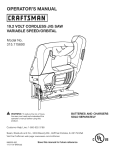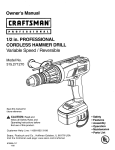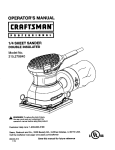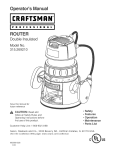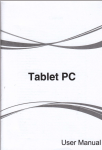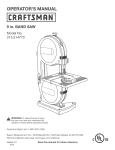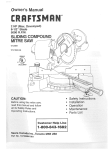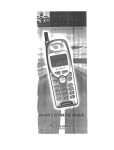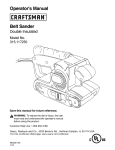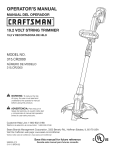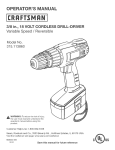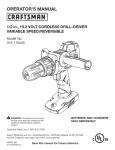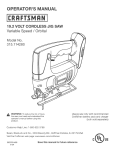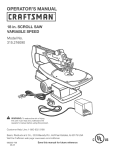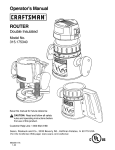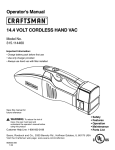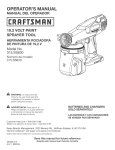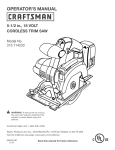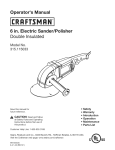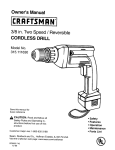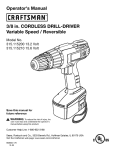Download Craftsman 315.115120 Operator`s manual
Transcript
19.2 VOLT NAILER/STAPLER
Model No.
315.115120
_
WARNING:
To reduce the risk of injury,
the user must read and understand the
operator's manual before using this
product.
Customer
Help Line: 1E800E932E3188
Sears, Roebuck
and Co., 3333 Beverly Rd., Hoffman
Estates, IL 60179 USA
Visit the Craftsman web page: www.sears.com!craftsman
983000-560
7-04
Save this manual
for future
reference
FULL ONE YEAR WARRANTY
ON ORAFTSMAN
TOOL
(f this CRAFTSMAN
too! fails to give comp(ete satisfaction within one year from the date of purchase, RETURN IT TO
THE NEAREST SEARS STORE OR SEARS SERV(OE CENTER (N THE UNITED STATES, and Sears w(l( repair it, free
of charge.
(f this CRAFTSMAN
of purchase.
too( is used for commercial
or renta( purposes, this warranty applies for on(y 90 days from the date
This warranty gives you specific lega( rights, and you may also have other rights which vary from state to state.
Sears, Roebuck
and Co., Dept. 817WA, Noffrnan Estates, (L 60179
This tool has many features for making its use more pleasant and enjoyable. Safety, performance, and dependability
have been given top priority in the design of this product making it easy to maintain and operate.
WARNING!READANDUNDERSTAND
ALLIN°
STRUOTIONS.
Failureto followallinstructionslisted
below,mayresultin electricshock,fireand/orserf
ouspersonalinjury.
SAVE THESE INSTRUCTIONS
WORK AREA
[] Keep your work area clean and well lit. Cluttered
benches and dark areas invite accidents.
[] Do not operate power tools in explosive atmospheres, such as in the presence of flammable liquids, gases, or dust. Power tools create sparks which
may ignite the dust or fumes.
[] Keep bystanders, children, and visitors away while
operating a power tool. Distractions can cause you to
lose control.
ELECTRICAL
SAFETY
[] A battery operated tooJ with integraJ batteries or a
separate battery pack must be recharged only with
the specified charger for the battery. A charger that
may be suitable for one type of battery may create a
risk of fire when used with another battery.
[] Use battery operated tool only with specifically designated battery pack. Use of any other batteries may
create a risk of fire.
[] Use battery
MODEL
315.115120
only with charger
listed.
BATTERY PACK
1323517 or 1323903
(Item No. 911375}
CHARGER
1425301
(Item No. 911041)
[] Do not abuse the cord. Never use the cord to carry
the charger. Keep cord away from heat, oil, sharp
edges, or moving parts. Replace damaged cords
immediately. Damaged cords may create a fire.
PERSONAL
SAFETY
[] Stay alert, watch what you are doing and use corn=
mon sense when operating a power tool. Do not
use tool while tired or under the influence of drugs,
alcohol, or medication. A moment of inattention while
operating power tools may result in serious personal
injury.
[] Dress properly. Do not wear loose clothing or
jewelry. Contain long hair. Keep your hair, clothing,
and gloves away from moving parts. Loose clothes,
jewelry, or long hair can be caught in moving parts.
[] Avoid accidental starting. Be sure switch is in the
locked or off position before inserting battery pack.
Carrying tools with your finger on the switch or inserting the battery pack into a tool with the switch on
invites accidents.
[] Remove adjusting keys or wrenches before turning
the tool on. A wrench or a key that is left attached to a
rotating part of the tool may result in personal injury.
[] Do not overreach. Keep proper footing and balance
at all times. Proper footing and balance enable better
control of the tool in unexpected situations.
[] Use safety equipment. Always wear eye protection.
Dust mask, non=skid safety shoes, hard hat, or hearing
protection must be used for appropriate conditions.
[] Do not wear loose clothing or jewelry. Contain long
hair. Loose clothes, jewelry, or long hair can be drawn
into air vents.
[] Do not use on a ladder or unstable support. Stable
footing on a solid surface enables better control of the
tool in unexpected situations.
TOOL USE AND CARE
[] Use clamps or other practical way to secure and
support the workpiece to a stable platform. Holding
the work by hand or against your body is unstable and
may lead to loss of control.
[] Do not force tool. Use the correct tool for your up=
plication. The correct tool will do the job better and
safer at the rate for which it is designed.
[] Do not use tool if switch does not turn it on or off.
A tool that cannot be controlled with the switch is dangerous and must be repaired.
[] Disconnect battery pack from tool or place the
switch in the locked or off position before making
any adjustments, changing accessories,
or storing
the tool. Such preventive safety measures reduce the
risk of starting the tool accidentally.
[] Store idle tools out of reach of children and other
untrained persons. Tools are dangerous in the hands
of untrained users.
[] When battery pack is not in use, keep it away from
other metal objects like: paper clips, coins, keys,
nails, screws, or other small metal objects that can
make a connection from one terminal to another.
Shorting the battery terminals together may cause
sparks, burns, or a fire.
[] Maintain tools with care. Keep cutting tools sharp
and clean. Properly maintained tools with sharp cut=
ting edges are less likely to bind and are easier to
control.
[] Check for misalignment
or binding of moving parts,
breakage of parts, and any other condition that
may affect the tool's operation, if damaged, have
the tool serviced before using. Many accidents are
caused by poorly maintained tools.
[] Use only accessories that are recommended
by the
manufacturer for your model. Accessories that may
be suitable for one too! may create a risk of injury when
used on another too!.
[] Keep the tool and its handle dry, clean and free
from oil and grease. Always use a clean cloth when
cleaning. Never use brake fluids, gasoline, petroleumbased products, or any strong solvents to clean your
too!. Following this rule wil! reduce the risk of loss of
control and deterioration of the enclosure plastic.
SERVmCE
[] Tool service must be performed only by qualified
repair personnel. Service or maintenance performed
by unqualified personnel may result in a risk of injury.
[] Hold tool by insulated gripping surfaces when
performing an operation where the cutting tool may
contact hidden wiring. Contact with a "live" wire will
also make exposed metal parts of the tool "live" and
shock the operator.
[] Know your power tool. Read operator's manual
carefully. Learn its applications and limitations, as
well as the specific potential hazards related to this
tool. Following this rule will reduce the risk of electric
shock, fire, or serious injury.
[] Always wear safety glasses with side shields.
Everyday glasses have only impact resistant lenses.
They are NOT safety glasses. Following this rule wil!
reduce the risk of eye injury.
[] Battery tools do not have to be plugged into an
electrical outlet; therefore, they are always in
operating condition. Be aware of possible hazards
when not using your battery tool or when changing
accessories.
Following this rule will reduce the risk of
electric shock, fire, or sedous personal injury.
[] Do not place battery tools or their batteries near
fire or heat. This will reduce the risk of explosion and
possibly injury.
[] When servicing a tool, use only identical replace=
merit parts. Follow instructions in the Maintenance
section of this manual. Use of unauthorized parts or
failure to follow Maintenance hstructions may create a
risk of shock or injury.
[] Never use a battery that has been dropped or
received a sharp blow. A damaged battery is subject
to explosion. Properly dispose of a dropped or dam=
aged battery immediately.
[] Batteries vent hydrogen gas and can explode in
the presence of a source of ignition, such as a pilot
light. To reduce the risk of serious personal injury,
never use any cordless product in the presence of
open flame. An exploded battery can propel debris and
chemicals. If exposed, flush with water immediately.
[] Do not charge battery tool in a damp or wet loca=
tion. Following this rule will reduce the risk of electric
shock.
[] For best results, your battery tool should be
charged in a location where the temperature
is
more than 50°F but less than 100°F. Do not store
outside or in vehicles.
[] Under extreme usage or temperature conditions, battery leakage may occur, if liquid comes
in contact with your skin, wash immediately with
soap and water, then neutralize with lemon juice
or vinegar, if liquid gets into your eyes, flush them
with clean water for at least 10 minutes, then seek
immediate medical attention. Following this rule wil!
reduce the risk of serious personal injury.
WARNING!
READ AND UNDERSTAND ALL
INSTRUCTIONS. Failure to follow al[ instructions
a. That pins on plug of extension cord are the
same number, size and shape as those of
plug on charger.
listed below, may result in electric shock, fire
and/or serious personal injury.
b. That extension cord is properly wired and in
good electrical condition; and
[] Before using battery charger, read all instructions
and cautionary markings in this manual, on battery
charger, battery, and product using battery to prevent
misuse of the products and possible injury or damage.
c. That wire size is large enough for AC ampere
rating of charger as specified below:
CAUTION: To reduce the risk of electric shock or
damage to the charger and battery, charge only
nickeFcadmium rechargeable batteries as specifi=
cally designated on your charger. Other types of
batteries may burst, causing personal injury or
damage.
Cord Length (Feet)
25'
50'
100'
Cord Size (AWG)
16
16
16
NOT_=:AWG = American Wire Gage
[] Do not operate charger with a damaged cord or
plug, which could cause shorting and electric shock. If
damaged, have the charger replaced by an authorized
serviceman.
[] Do not operate charger if it has received a sharp
blow, been dropped, or otherwise damaged in any
way. Take it to an authorized serviceman for electrical
check to determine if the charger is in good working
order.
[] Do not use charger outdoors or expose to wet or
damp conditions. Water entering charger will increase
the risk of electdc shock.
[] Use of an attachment not recommended
or sold
by the battery charger manufacturer
may result in
a risk of fire, electric shock, or injury to persons.
Following this rule will reduce the risk of electric shock,
fire, or serious personal injury.
[] Do not disassemble charger. Take it to an authorized
serviceman when service or repair is required. Incorrect reassembly may result in a risk of electric shock or
fire.
[] Do not abuse cord or charger. Never use the cord to
carry the charger. Do not pul! the charger cord rather
than the plug when disconnecting from receptacle.
Damage to the cord or charger could occur and create
an electric shock hazard. Replace damaged cords im=
mediately.
[] Make sure cord is located so that it will not be
[] Unplug charger from outlet before attempting any
maintenance or cleaning to reduce the risk of electric shock.
[] Disconnect charger from the power supply when
not in use. This will reduce the risk of electric shock
or damage to the charger if metal items should fall into
the opening. It also will help prevent damage to the
charger during a power surge.
[] Risk of electric shock. Do not touch uninsu[ated
stepped on, tripped over, come in contact with
sharp edges or moving parts or otherwise subjected to damage or stress. This will reduce the risk of
accidental falls, which could cause injury, and damage
to the cord, which could result in electric shock.
portion of output connector or uninsulated battery
terminal.
[] Keep cord and charger from heat to prevent dam=
age to housing or internal parts.
Save these instructions.
Refer to them frequently and
use them to instruct others who may use this tool. If
you loan someone this tool, loan them these instructions also to prevent misuse of the product and pos=
s[ble injury.
[] Do not let gasoline, oils, petroleum=based
products,
etc. come in contact with plastic parts. They contain
chemicals that can damage, weaken, or destroy plastic.
[] An extension cord should not be used unless ab=
solutely necessary. Use of improper extension cord
could result in a risk of fire and electric shock. If extension cord must be used, make sure:
_
WARNING:
Some dust created by power sanding, sawing, grinding, drilling, and other construction activities contains chemicals known to cause cancer, birth defects or other reproductive harm. Some examples of these chemi=
cals
are:
, lead from lead-based paints,
• crystalline silica from bricks and cement and other masonry products, and
• arsenic and chromium from chemically-treated lumber.
Your risk from these exposures varies, depending on how often you do this type of work. To reduce your exposure
to these chemicals: work in a well ventilated area, and work with approved safety equipment, such as those dust
masks that are specially designed to filter out microscopic particles.
5
Someof the followingsymbolsmaybe usedon this tool. Pleasestudythemand learntheirmeaning.Proper
interpretation
of thesesymbolswillallowyouto operatethe too!betterandsafer.
SYMBOL
NAME
DESIGNATION/EXPLANATmON
V
Volts
Voltage
A
Amperes
Current
Hz
Hertz
Frequency(cyclespersecond)
W
Watt
Power
min
Minutes
Time
AlternatingCurrent
Typeofcurrent
DirectCurrent
Typeor a characteristic
of current
NoLoadSpeed
Rotationalspeed,at no load
ClassII Construction
Doubleqnsulated
construction
Per Minute
Revolutions,
no
.../rain
Wet Conditions
Alert
Read The Operator's
Do not expose to rain or use in damp locations.
Manual
To reduce the risk of injury, user must read and understand
operator's manual before using this product.
Eye Protection
Always wear safety goggles or safety glasses with side
shields and a ful! face shield when operating this product.
Safety Alert
Precautions that involve your safety.
No Hands Symbol
Failure to keep your hands away from the blade will result in
serious personal injury.
No Hands Symbol
Failure to keep your hands away from the blade will result in
serious personal injury.
No Hands Symbol
®
strokes, surface speed, orbits etc., per minute
Failure to keep your hands away from the blade will result in
serious personal injury.
No Hands Symbol
Failure to keep your hands away from the blade will result in
serious personal injury.
Hot Surface
To reduce the risk of injury or damage, avoid contact with
any hot surface.
6
Thefollowingsignalwordsandmeanings
areintendedto explainthe levelsof riskassociatedwiththisproduct.
SYMBOL
SIGNAL
MEANING
DANGER:
indicates an imminently hazardous situation, which, if not avoided, wil!
result in death or serious injury.
WARNING:
indicates a potentially hazardous situation, which, if not avoided, could
result in death or serious injury.
CAUTmON:
indicates a potentially hazardous situation, which, if not avoided, may
result in minor or moderate injury.
CAUTmON:
(Without Safety Alert Symbol) Indicates a situation
property damage.
SERVICE
Servicing requires extreme care and knowledge and
should be performed only by a qualified service technician. For service we suggest you return the product
to your nearest AUTHORIZED SERVtOL= CENTER for
repair. When servicing, use only identical replacement
parts.
that may result in
WARNING:
To avoid serious personal injury,
do not attempt to use this product until you read
thoroughly and understand completely the
operator's manual. Save this operator's manual
and review frequently for continuing safe operation and instructing others who may use this
product.
WARNING:
The operation of any power tool can result in foreign objects being thrown into your eyes,
which can result in severe eye damage. Before beginning power tool operation, always wear
safety goggles or safety glasses with side shields and a full face shield when needed. We recommend Wide Vision Safety Mask for use over eyeglasses or standard safety glasses with side
shields. Always use eye protection which is marked to comply with ANSI Z87.!.
SAVE THESE INSTRUCTIONS
SPECIFICATIONS
Motor ...................................................................................................................................................................
Switch ........................................................................................................................................................
19.2 Volt DC
Single Shot Trigger
Staple Speed .....................................................................................................................................................
Staple Size .....................................................................................................
40 shots/rain.
3=-50!/4, 5/!6, 3/8, !/2, 17/32, 9/16 in. length
Brad Size .............................................................................................................................
!8 gauge, 3/4, !, !-1/4 in. length
Magazine Capacity .........................................................................................................................................
Charger hput .......................................................................................................................................
100 staple/brad
!20 V, 60 Hz, AC only
Charge Rate .................................................................................................................................................................
! Hour
HANDLE
SWITCH
TRIGGER
DEPTH ADJUS
KNOB
BATTERYPACK
SHOWNIN TOOL
LOCK OFF BUTTON
BATTERYPACK
SHOWNIN CHARGER
MAGAZINE
ACTIVATION
FOOT
RED LED
LED
LED
CAUTION
Do not use any DO to AC power
invertera= Charger wiJ| be #amaged!
!
Fig. 1
KNOW YOUR
CORDLESS
NAILER/STAPLER
See Figure 1.
SWITCH
TRmGGER
Before attempting to use this product, familiarize yourself
with all operating Features and Safety Rules.
The switch trigger is conveniently located under the
handle. Pulling the switch trigger will fire one nail or staple
at a time.
CHARGER
SAFETY
Your charger has a "key hole" hanging feature for convenient, space saving storage. Screws should be installed
so that center distances are 4-1,/2 in. apart.
The safety interlock prevents the nailer/stapler from
turning on accidentally. Push the activation foot of the
naitedstapler down flush to the workpiece to disengage
the safety interlock.
LOCK-OFF
BUTTON
This tool is equipped with a "lock-off" button which
reduces the possibility of accidental starting. The lock-off
button is located on both sides of the handle above the
switch trigger. You must depress the lock-off button in
order to pull the switch trigger. The lock resets each time
the switch trigger is released.
DEPTH
mNTERLOCK
ADJUSTMENT
KNOB
Use the depth adjustment knob to control the depth of the
staple or brad nail.
NOTE: You can depress the lock-off button from either the
left or right side.
UNPACKING
This product has been shipped completely assembled.
[] Carefully remove the tool and accessories from the
box. Make sure that al! items listed in the packing list
are included.
[] Inspect the tool carefully to make sure no breakage or
damage occurred during shipping.
[] Do not discard the packing material unti! you have
carefully inspected and satisfactorily operated the tool.
[] If any parts are damaged or missing, please call
1-800-932-3!88 for assistance.
PACKING
MST
Nailer/Stapler
Charger
Battery Pack
1 in. Brads (100 pcs)
1/2 in. Staples (84 pcs)
Case
Operator's
Manual
WARNING:
If any parts are missing do not operate
the tool unti! the missing parts are replaced. Failure
to do so could result in possible serious personal
injury.
WARNING:
Do not attempt to modify this tool
or create accessories not recommended for use
with this tool. Any such alteration or modification is
misuse and could result in a hazardous condition
leading to possible serious personal injury.
WARNING:
To prevent accidental starting that
could cause serious personal injury, always remove
the battery pack from the tool when assembling
parts.
_
_
CHARGING
WAF{NJNG:Donotallowfamiliaritywithtoolsto
makeyoucareless.Remember
thata careless
fractionofa secondissufficientto inflictserious
injury.
[] Make sure the power supply is normal household
voltage, 120 volts, 60 Hz, AO only.
You may use this tool for the following purposes:
[] Connect the charger to the power supply.
is designed for light-duty stapling or
[] Place the battery pack in the charger aligning raised rib
on the battery pack with the groove in the charger. See
Figure 1.
CAUTION:
To prevent damage to the battery pack,
remove the battery pack from the charger immediately if no LED comes on. Return the battery pack
and charger to your nearest service center for checking or replacing. Also, if you are removing the battery
pack from the charger and no LEDs are on, return
both the battery pack and the charger to your nearest service center. Do not insert another battery pack
into the charger. A damaged charger may
damage a battery pack.
LED WiLL
CHARGER
PACK
[] Charge the battery pack only with the charger provided.
APPLmCATIONS
LED FUNCTIONS
BATTERY
NOT6: If the charger does not charge the battery pack
under normal circumstances, return both the battery pack
and charger to your nearest Sears Repair Center for
electrical check.
WAF{NING:Alwayswearsafetygogglesor safety
glasseswithsideshieldswhenoperatingtools.
Failureto doso couldresultinobjectsbeingthrown
intoyoureyes,resultinginpossibleseriousinjury.
[] This Nailer/Stapler
nailing into wood.
A COOL
If battery pack is below normal temperature range, the
green LED on charger will come on. Allow battery pack to
reach normal temperature, then the red LED will come on.
[] Press down on the battery pack to be sure contacts on
the battery pack engage properly with contacts in the
charger.
[] Normally the red LED on charger will come on. This
indicates the charger is in fast charging mode.
[] Red LED should remain on for approximately 1 hour
then the green LED will come on. Green LED on
indicates battery pack is fully charged and charger is
in maintenance charge mode.
NOT6: The green LED will remain on until the battery
pack is removed from the charger or charger is
disconnected from the power supply.
OF CHARGER
BE ON TO iNDiCATE STATUS OF
AND BATTERY PACK:
[] Green LED on = When battery pack is inserted into
charger, indicates hot battery pack or that battery pack
is out of normal temperature range.
[] If both yellow and green LEDs come on, this indicates
a deeply discharged or defective battery pack. Allow
the battery pack to remain in the charger for 15 to 30
minutes. When the battery pack reaches normal
voltage range, the red LED should come on. If the red
LED does not come on after 30 minutes, this may
indicate a defective battery pack and should be
replaced.
[] Yellow and Green LEDs on = Deeply discharged or
defective battery pack.
[] After normal usage, a minimum of 1 hour of charging
time is required to fully recharge battery pack.
[] No LED on = Defective charger or battery pack.
[] The battery pack wil! become slightly warm to the
touch while charging. This is normal and does not
indicate a problem.
[] Red LED on = Fast charging mode.
[] Green LED on = Fully charged and in maintenance
charge mode.
CHARGING
THE BATTERY
PACK
The battery pack for this tool has been shipped in a low
charge condition to prevent possible problems. Therefore,
you should charge it until the green LED on the front of the
charger comes on.
[] Do not place the charger and battery pack in an area
of extreme heat or cold. They win work best at normal
room temperature.
NOT6: The charger and batten/pack should be placed
in a location where the temperature is more than 50°F
but less than 100°F.
NOT6: Batteries will not reach full charge the first time
they are charged. Allow several cycles (operation followed
by recharging) for them to become fully charged.
[] When batteries become fully charged, unplug the
charger from power supply and remove the battery
pack.
10
CHARGmNG A HOT BATTERY
PACK
TO REMOVE
BATTERY
PACK
When using the tool continuously, the batteries in the
battery pack will become hot. You should let a hot bat=
tery pack cool down for approximately 30 minutes before
attempting to recharge. When the battery pack becomes
discharged and is hot, this will cause the green LED to
come on instead of the red LED. After 30 minutes, reinsert
the battery pack in the charger. Hfthe green LED continues
to remain on, return battery pack to your nearest Sears
Repair Center for checking or replacing.
See Figure 2.
NOTE: This situation only occurs when continuous use of
the too! causes the batteries to become hot. Htdoes not
occur under normal circumstances. Refer to "CNARG=
ING A COOL BATTERY PACK" for normal recharging
of batteries. Hfthe charger does not charge your battery
pack under normal circumstances, return both the battery
pack and charger to your nearest Sears Repair Center for
electrical check.
[] Hold toot upside down; squeeze latch and slide base
open.
TO mNSTALL BATTERY
m Locate latches on side of battery pack and depress to
release battery pack from the tool.
[] Remove battery pack from the tool.
LOADmNG THE TOOL
See Figures 3- 4.
WITH
STAPLES
[] Remove battery pack from the tool,
[] Place staples in channel, legs facing upward and close
base.
[] Make sure the latch is securely locked in place.
[] Reattach battery pack to tool.
PACK
See Figure 2.
[] Place battery pack in your tool. Align raised rib on
battery pack with groove inside tool.
[] Make sure the latches on each side of the battery
pack snap in place and battery pack is secured in tool
before beginning operation.
_l
LATCH
CAUTION: When placing battery pack in the tool,
be sure raised rib on battery pack aligns with groove
inside tool and latches snap into place properly.
Improper assembly of battery pack can cause
damage to internal components.
Fig. 3
BATTEBY
STAPLES
LATCHES
DEPRESS LATCHESTO
BELEASEBATTERYPACK
Fig. 2
Fig. 4
11
LOADING
THE TOOL WiTH
NAILS
See Figures 3 - 5.
[] Remove battery pack from the tool.
[] Hold too! upside down; squeeze latch and s(ide base
open.
[] P(ace nails in the center of the channe( with "T" head
sitting on the s(ot base. Close base while making sure
ha(( stdp stays upright in channel.
NOTE;: There are two channels for the nai(s. Use the
sma((er channel for na(Is sized 3,/4 in, to 1 in, Use the
(arger channe( for na(Is s(zed 1-1,/4 in. Refer to mo(d(ng
on the too(,
F(g. 6
[] Make sure that the (atch (s secure(y (ocked in p(ace.
NAILING
[] Reattach battery pack to tool.
OF{ STAPLING
See Figure 7.
[] Hold handle firmly with magazine flat to workplece
forming a 90 ° angle.
[] Press the activation foot of the nailer/stapler down
against the workpiece to disengage the safety
interlock, The activation foot must be depressed before
the lock-off button and switch trigger are depressed,
[] Depress the lock-off button from either the left or right
side and pull switch trigger to drive nail or staple.
[] Release the switch trigger and activation foot before
dr(ving another nai! or staple.
NOTE;: You must release the activation foot and
switch trigger after each nail or staple to reset the too!.
The tool w(l! not fire another staple or nail until the
activation foot and switch trigger are released.
(
SETTING DEPTH
See Figure 6.
[] Rotate the depth adjustment knob clockwise to use
more force for nai(ing or stapi(ng,
[] Rotate depth adjustment knob counterc(ockwlse
(ess force for nai(ing or stapling,
to use
[] Test on a scrap piece of the same mater(al you are
using to achieve the desired results.
NOTE: Harder materials wi(( require more force to ha((
or stap(e.
Fig. 7
12
REMOVmNG A JAMMED
NAta!!STAPLE
m Remove jammed nail/staple with needle nose pliers.
Remove battery pack from the tool.
NOTE: You must remove jammed nail/staple before
using tool any further. Hfyou try to fire a nail/staple
while the tool is jammed, you could cause damage to
the mechanism.
m Hold tool upside down; squeeze latch and slide base
open.
m Remove unused nails/staples from magazine.
_
_
_
GENERAL
WARNING:
When servicing, use only identical
Craftsman replacement parts. Use of any other part
may create a hazard or cause product damage.
Avoid using solvents when cleaning plastic parts. Most
plastics are susceptible to damage from various types of
commercial solvents and may be damaged by their use.
Use clean cloths to remove dirt, dust, oil, grease, etc.
WARNING:
Always wear safety goggles or safety
glasses with side shields when using compressed air
to clean tools. Hfthe operation is dusty, also wear a
dust mask.
_
WAF{NING: To avoid serious personal injury, always
remove the battery pack from the tool when cleaning
or performing any maintenance.
BATTERY PACK REMOVAL AND
PREPARATION
FOR RECYCUNG
To preserve natural resources, please
recycle or dispose of batteries
properly.
The batteries in this too! have been designed to provide
maximum trouble-free life. However, like all batteries, they
will eventually wear out. Do not disassemble battery pack
and attempt to replace the batteries. Handling of these
batteries, especially when wearing rings and jewelry, could
result in a serious burn.
This product contains nickel-cadmium
batteries. Local, state or federal
laws may prohibit disposal of nickelcadmium batteries in ordinary trash.
Consult your !ocal waste authority for information
regarding available recycling and/or disposal options.
To obtain the longest possible battery life, we suggest the
following:
WARMNG:
Upon removal, cover the battery pack's
terminals with heavy-duty adhesive tape. Do not
attempt to destroy or disassemble battery pack or
remove any of its components. Nicke!-cadmium
batteries must be recycled or disposed of properly.
Also, never touch both terminals with metal objects
and/or body parts as short circuit may result. Keep
away from children. Failure to comply with these
warnings could result in fire and/or serious injury.
[] Remove the battery pack from the charger once it is
fully charged and ready for use.
For battery pack storage longer than 30 days:
[] Store battery packs in a "discharged"
WARMNG:
Do not at any time let brake fluids,
gasoline, petroleum-based products, penetrating
oils, etc. come in contact with plastic parts. Chemicals can damage, weaken or destroy plastic which
may result in serious personal injury.
Only the parts shown on the parts list are intended to be
repaired or replaced by the customer. All other parts
should be replaced at a Sears Service Center.
The battery pack for this tool is equipped with nickel=cadmium rechargeable batteries. Length of service from each
charging will depend on the type of work you are doing.
[] Store the battery pack where the temperature
80°F.
MAmNTENANCE
is below
condition.
13
CRAFTSMAN
19.2 VOLT CORDLESS
SEE BACK
NAILER/STAPLER
PAGE FOR PARTS ORDERING
- MODEL
NO. 315.115120
iNSTRUCTiONS
3
PARTS LiST
Key
No.
Part
Number
Description
1
102334001035
Cartridge
2
1323517
Battery
Pack (* Item No. 9 11375) ...................................................
1
3
1425301
Charger
(*Item No, 9 11041) ...........................................................
1
983000=560
Operator's
or 1323903
* Can
Be Purchased
Qty.
Assembly
Manual
Thru
........................................................................
..........................................................................
RSOS
!4
(Retait
Special
Order
System)
1
1














